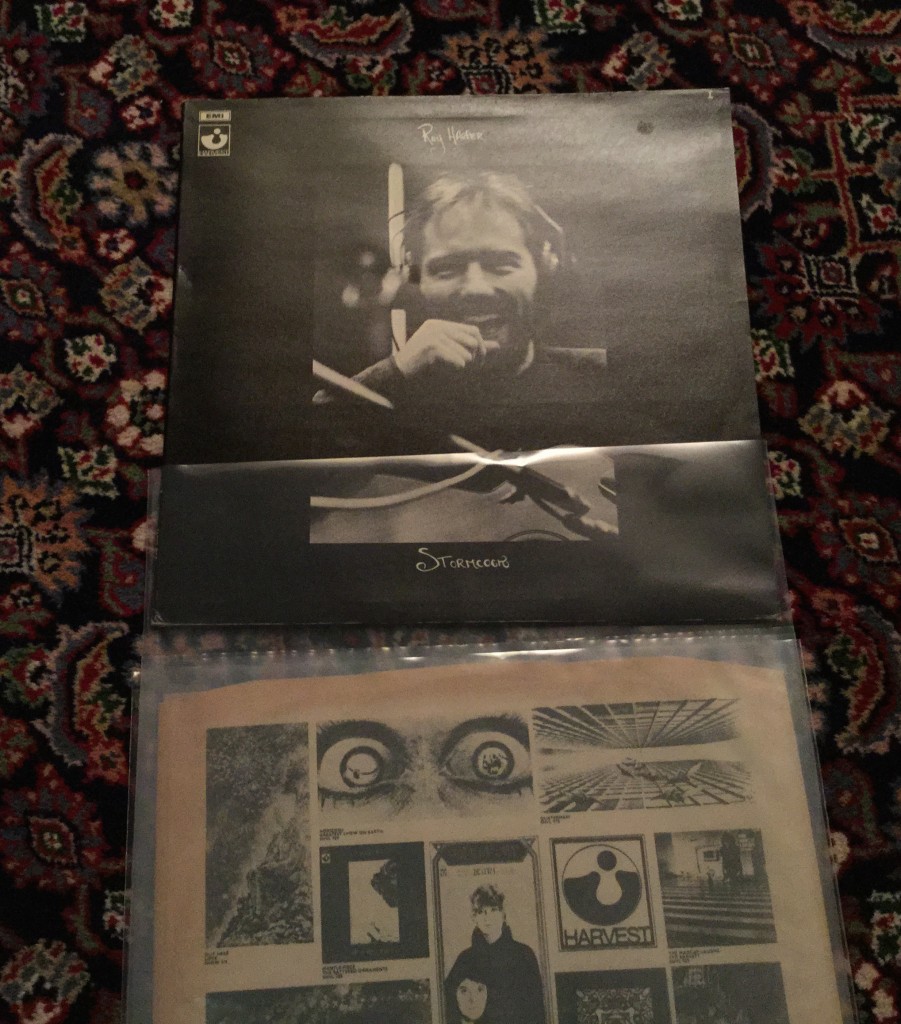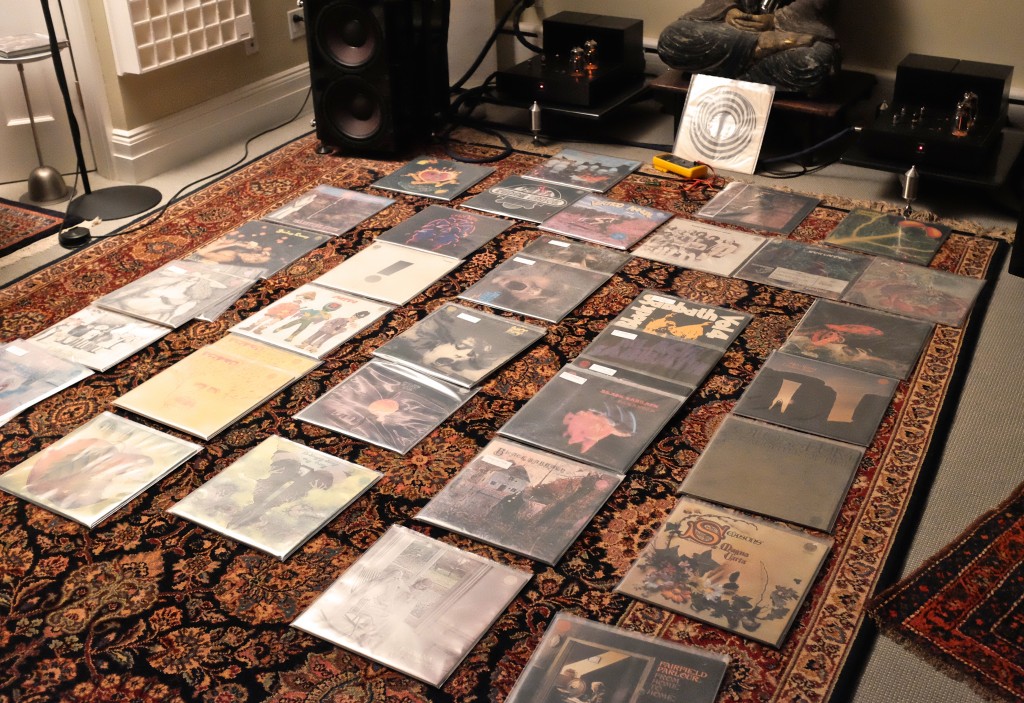
My interview with Robert Croydon of EIL-Esprit, a well-known UK record dealer inspired me to create a set of tips for buying used records. Some of this is common sense, basic knowledge to anybody who collects, so please accept this as nothing more than “blithering insights into the obvious” if you are already an experienced buyer of used vinyl.
Consider The Source:
Are you buying from a dealer or an individual?
The level of knowledge among record sellers varies widely, regardless of whether they are established dealers, individuals trying to unload vinyl that they accumulated or inherited, or regular online sellers who do used vinyl as a side business. Even dealers and knowledgeable sellers cannot know everything within every genre. Treat all the information provided by a seller with a degree of skepticism- not because the seller is intentionally misleading but because you must verify what pressing is being offered as well as its condition. We will deal with these issues below.
Sources for used records range from places like E-Bay and Discogs and other online aggregators (platforms offering the wares of multiple sellers) to individual dealer websites, to brick and mortar stores, to garage, tag or yard sales. (All of these “yard sales” are now called ‘Estate Sales’ to make these treasures seem more valuable).
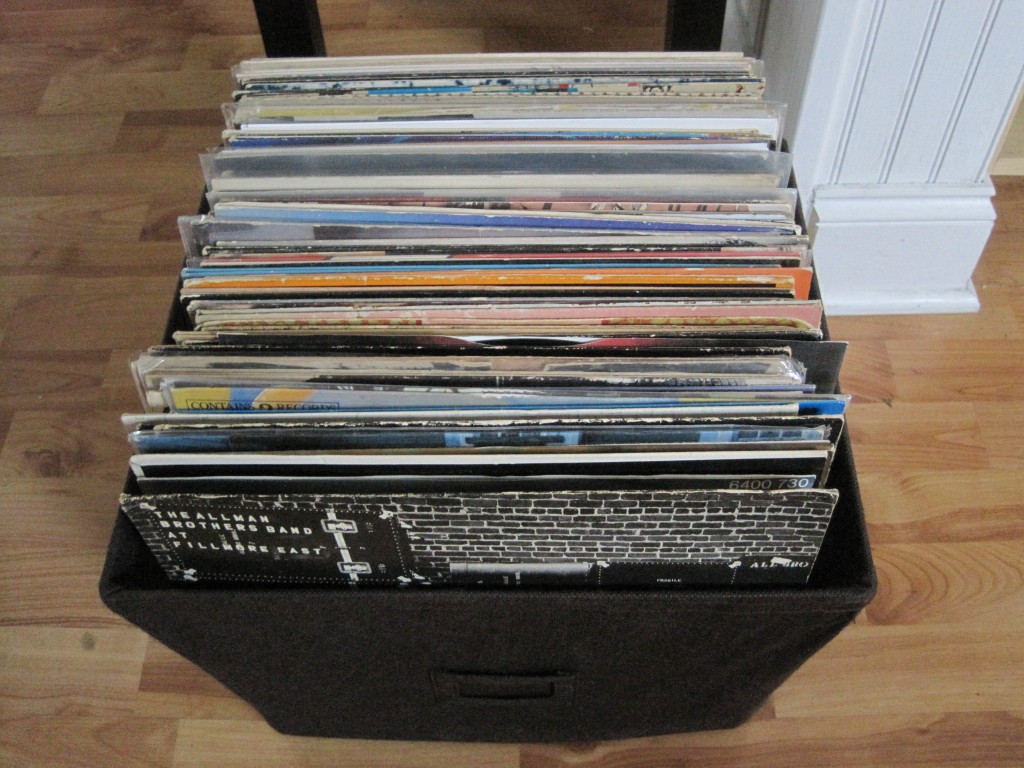
Evaluation- Factors
Obviously, if you are in a brick and mortar store, you can visually inspect the record, the jacket and inner sleeve (and if you have the knowledge, or online access, can check the deadwax).[1] I have been to record fairs that offer “play testing” on these tiny plastic record players to which I would never subject a record. (Some brick and mortar stores may offer you the ability to play test over a decent turntable, to listen for noise or other sonic gremlins, but it is not all that common). Another reason to give the record a ‘spin’ before you buy, even if you don’t ‘drop the needle’ on it, is to see how warped it is- you can eyeball a record held in your hand, but warps are best revealed by spinning the disc on a turntable platter.
Visual Telltales
Apart from identifying the particular pressing (each sounds different, sometimes to a remarkable degree), condition is everything. I’ve bought pristine looking records that were damaged (evident only after cleaning and playing), and records with surface marks, scuffs and hairline scratches that play fine, are quiet and keepers. Though a visual inspection can only tell you so much, it is still instructive: if you are buying from a dealer, the records have already been handled, re-crated and perhaps cleaned so even if you are in the store to inspect, you are not seeing the record(s) in their ‘native’ condition (assuming the seller was the original owner).
If you are buying- in person- from a yard sale or private individual, you look at everything- the manner in which the records are stored, the condition of the boxes in which they are stored, and the outer jackets, inner sleeves and vinyl itself. I have bought very rare records in tatty jackets or ones that contain the incorrect inner sleeves, where the record itself, after a good clean, plays fine. (These appeal less to hardcore collectors, because like the Westminster Dog Show or the Pebble Beach Concours- every tiny detail counts).[2] But, the better the external aspects of the record/jacket/inner are, the more likely you are to find something worthwhile, subject to the exception that swallows this rule- the pristine looking copy that suffers from groove damage that is not going to improve by a good cleaning.
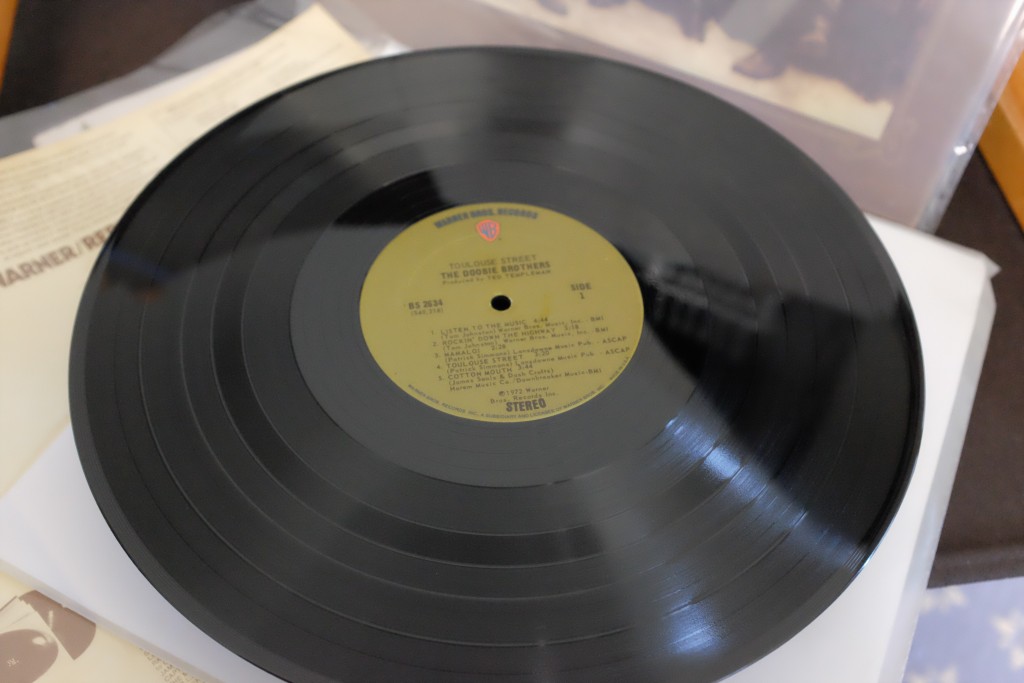
A “standard” issue Warner “Green” label- this record is fabulous sounding. Might cost you 6 bucks in a used bin. Condition is key.
Look for wear at the spindle hole, scratches (which may or may not be audible), fingerprints and other nasties, which may or may not clean up. [3] Off-center spindle holes are another problem, but one you can do little about (and remain a problem today with new pressings).
Obviously, if you are buying $2.00 records at a yard sale, charity shop or spending a few bucks more at a used record store, you risk little (Waterloo Records here in Austin allows you to return used records- even the $6-8 bin copies- but the policies of different vendors or aggregator sites may vary. The more expensive stuff should be subject to return, but a seller or aggregation platform can dictate terms that modify this). The ultimate test of playing condition is playing the record on your system, after it has been cleaned. (The cleaning, addressed elsewhere on this site at length, is to avoid grinding surface detritus into the grooves and will make a difference in noise, clarity and playability of the record. Recognizing that a damaged record cannot be salvaged by a deep cleaning, some records I would have recycled as irretrievably damaged were, in fact, just heavily contaminated and brought back to life by effective cleaning).
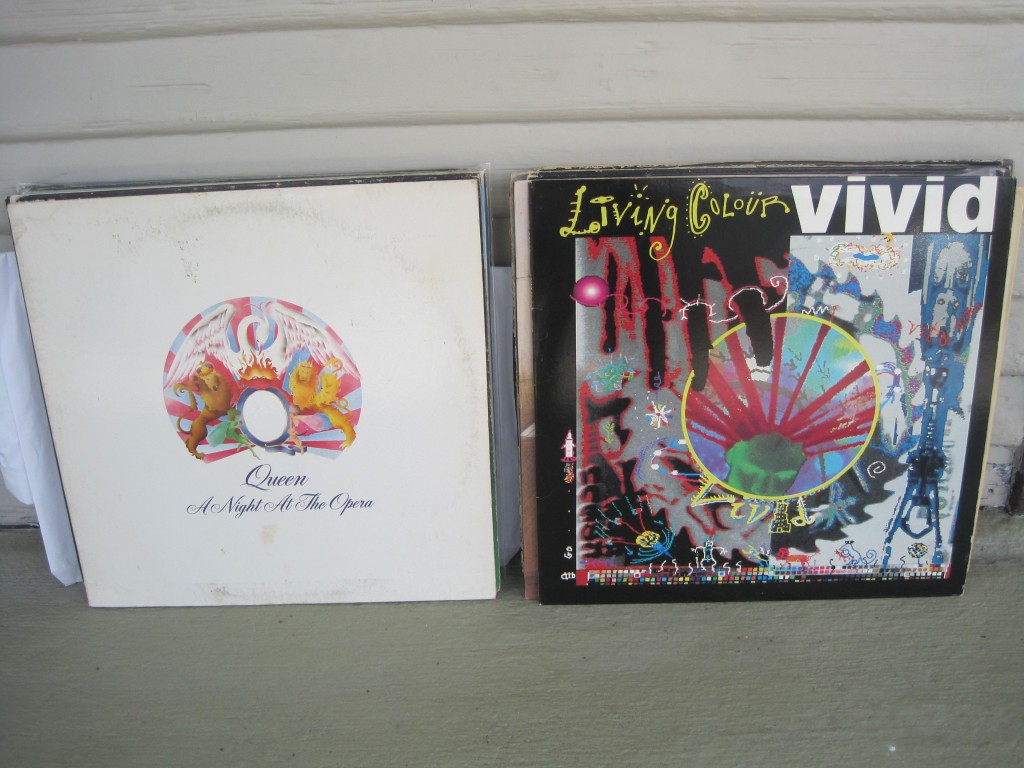
As you find it, natively. Depending on price, unless the record is trashed, it is probably worth the risk at a yard sale on the cheap. You may or may not be getting the preferred (and best sounding) pressing though, unless you check other details, including the deadwax, artwork, including label artwork and other details and match that to anecdotal comparisons of the sound or buy a bunch of copies and compare them yourself.
Sealed Records:
These are not attractive to me, though collectible, because once the shrink is opened, it has lost that “premium” value. More important, you are buying an unknown quantity- the fact that the record has been sealed for 30 or 40 years doesn’t mean it is perfect- in fact, records still in their original shrink-wrap (particularly of the old, tight-pulled thin shrink-wrap used in the U.S.) can often warp under the stress of the shrink-wrapping. Finally, record-making was never a 100% quality proposition even “back in the day” and many sellers will refuse to take returns of old “sealed” records. A re-shrink-wrapped record was not uncommon in the days of yore and no doubt occurs today as well. Practices also varied by country; some records were not shrink-wrapped originally when sold.[4] The biggest negative to me, on sealed records, at least for the expensive ones- is that you cannot evaluate the record itself, and neither can the seller. Sometimes, I do buy sealed older records, see the example below about Chris Whitley’s Dirt Floor.
Buying Online:
I try to establish a dialog with the seller, via email (or, if through a site like E-Bay or Discogs, through their messaging system which assures you that if there is a problem it is documented “in the system” for the intermediary to review if there is a dispute). This dialog tells me much about the knowledge of the seller, and therefore sheds some light on the description and grading. I’ve purchased records rated as VG+ (a pretty standard ‘used record’ rating that may or may not be accompanied by further description) that were sonically, if not visually pristine, and EX or other higher grade records that I simply recycled.
Does the seller allow you to return the record for a full refund? Check the fine print of the listing and the terms of the site. You will usually bear the cost of return shipping, which may not be worth it if it was a cheap record, but if an expensive record, the right to return it (and the terms under which you do so) are important.
Mis-Grading and Other Headaches
I’ve bought records online that were supposed to be first pressings that were not, or were catalogued in a category for a particular pressing, but were later pressings. (Bar coding is another telltale of a later pressing for a record originally issued in the 60’s or early 1970’s)
I’m not making a generalization about earliest or first pressings being better, but if there is a particular pressing you are after (more about this below), and you know the deadwax or other indicia, get the seller to send you photos and the relevant nomenclature in an email. Sometimes, the sellers are clueless and don’t know the difference- I don’t attribute this to willfulness by the seller but even if you could return the record, why go through all the trouble?
The photos are good for a couple things: the center label style/art varies over time- another telltale, as does outer jacket art/layout. And you might be able to see the condition of the outer jacket if that is important to you.
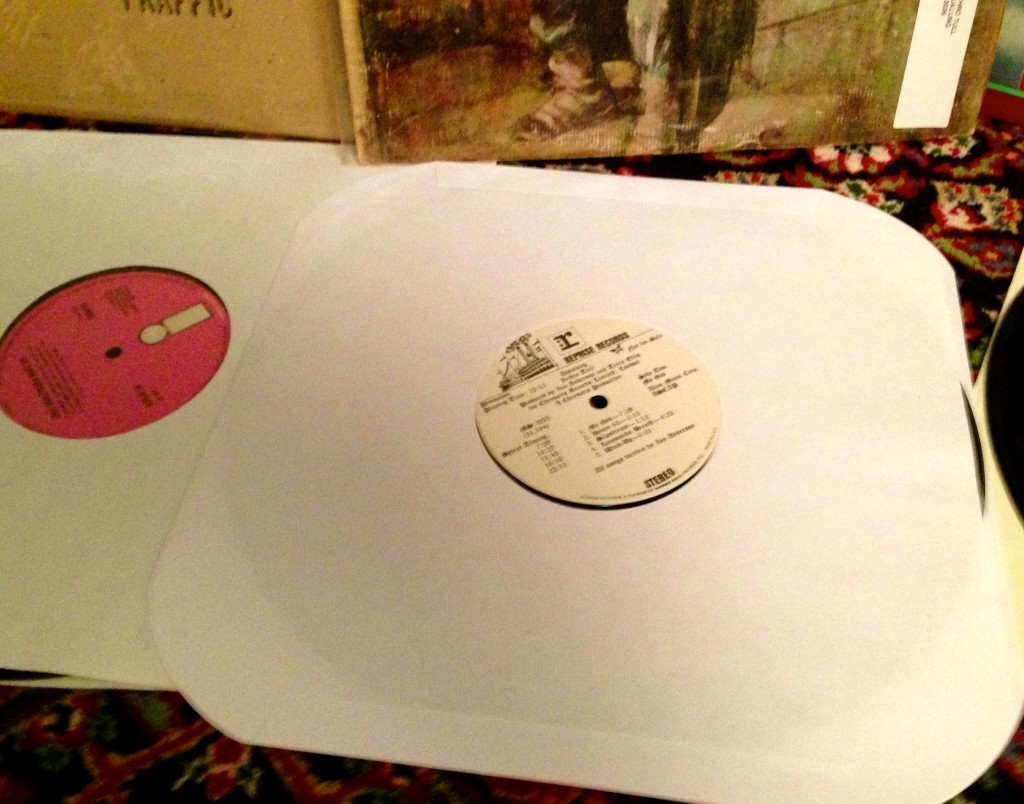
As received, before cleaning, and in aftermarket plain paper sleeves.
I’ve also found that this process tells me more about the history of the record itself. I bought a rare record from a gentleman who didn’t know what the term “deadwax’ information meant, but once he provided it, it verified what I needed to know; in the course of our messaging exchange, he told me he bought the record new when he lived in the UK and hadn’t listened to it in years. Good information, not entirely determinative, but telling. The record turned out to be a minty player, I paid a reasonable but not crazy price for it, and I think both of us were happy.
Play-Grading
Obviously, if the seller has play-graded the record (usually not all the way through, but spot checking, unless it is an expensive record), you have more information. But this is not foolproof either. My buddy Max bought a first U.S. mono of Hendrix “Are You Experienced” that had a fairly detailed seller description about the sonics suggesting a very nice sounding record. I listened to a bit of it- even after Max cleaned it, the record seemed to have a slight veil of constant noise.[5] So, even seller play-grading can be subjective.
What Pressing Should I Be Buying?
This is what makes the world go around. There are various sources for matrix numbers and deadwax nomenclature but as explained below, this information, if accurate, may only tell you in general terms what pressing you have, where it was pressed and perhaps who mastered it- and little to nothing about whether that pressing is a good or bad sounding record. Being a consumer of records since the mid-60’s, I’m still learning, and everybody and I mean everybody, has pockets of deep knowledge, and areas of complete ignorance.
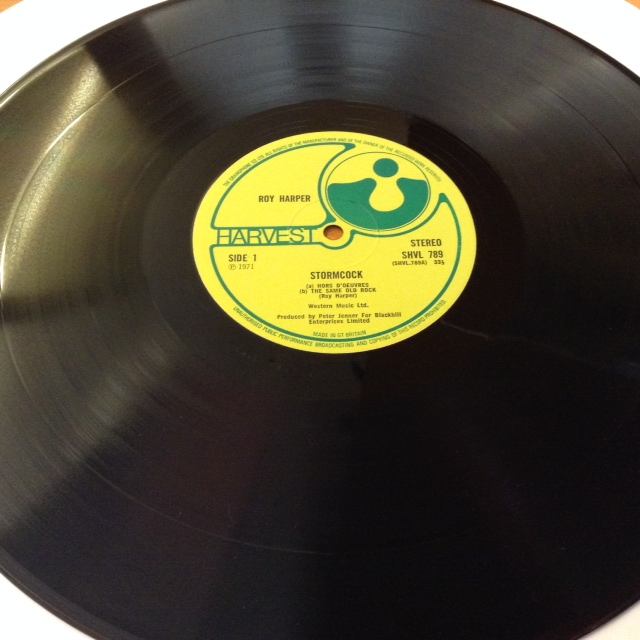
An early UK Harvest pressing of Roy Harper’s Stormcock. This copy does not have the EMI nomenclature of later pressings, and while it is not an uber record, pricewise (though a very cool one musically and sonically), it is not easy to find in minty condition. I bought this from a private seller located in the Mid-East.
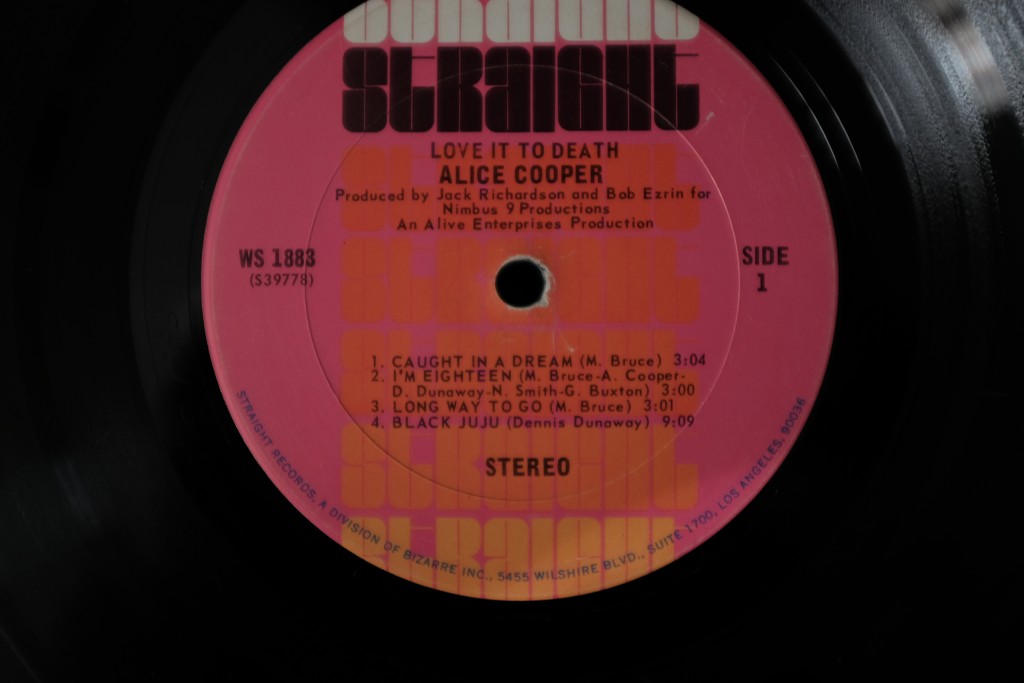
An early Straight Records label pressing of “Love it to Death”-not an easy record to find in decent playing condition, but these early pressings sound better, to my ears, than the later Warner ‘Green’ label copies (though some share the same matrix info).
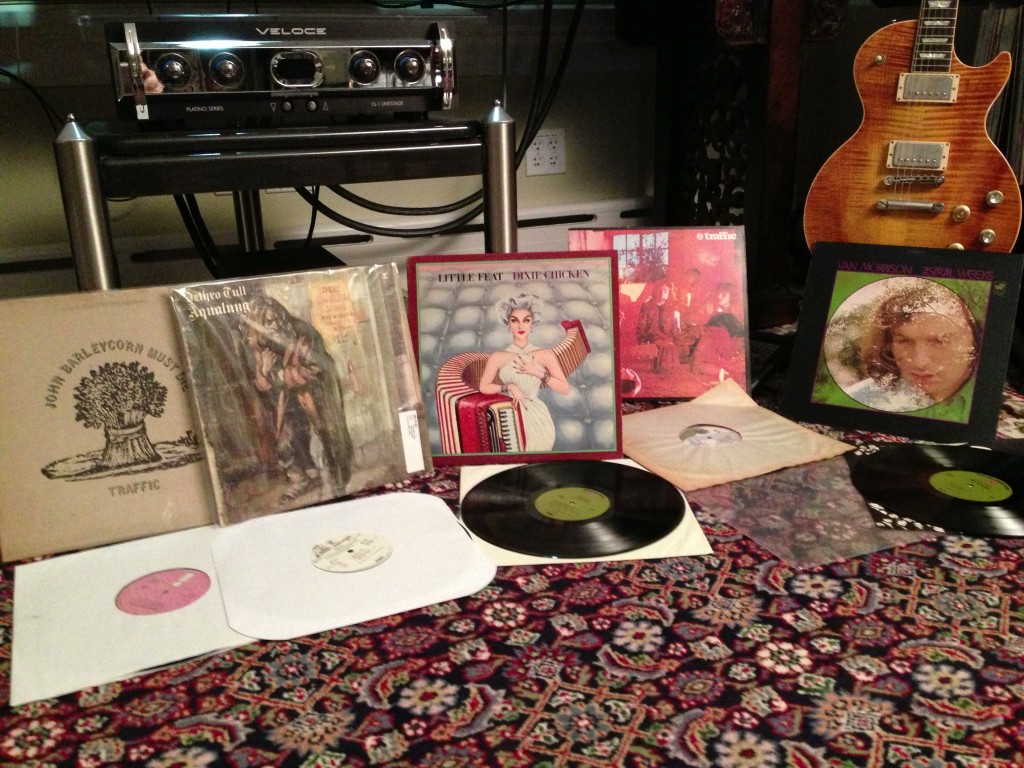
A mixture of great sounding records, ranging from an Island pink “i”, to a U.S. Tull white label promo (“WLP”) to a good ol’ Warner Green of Little Feat (which I subsequently found as a WLP on E-bay for about $60 bucks, thanks to a tip from another collector) and a UK pink rim (later pressing) of Traffic’s Mr. Fantasy. The Van Morrison at the far right is an early “W7” pressing and is desirable.
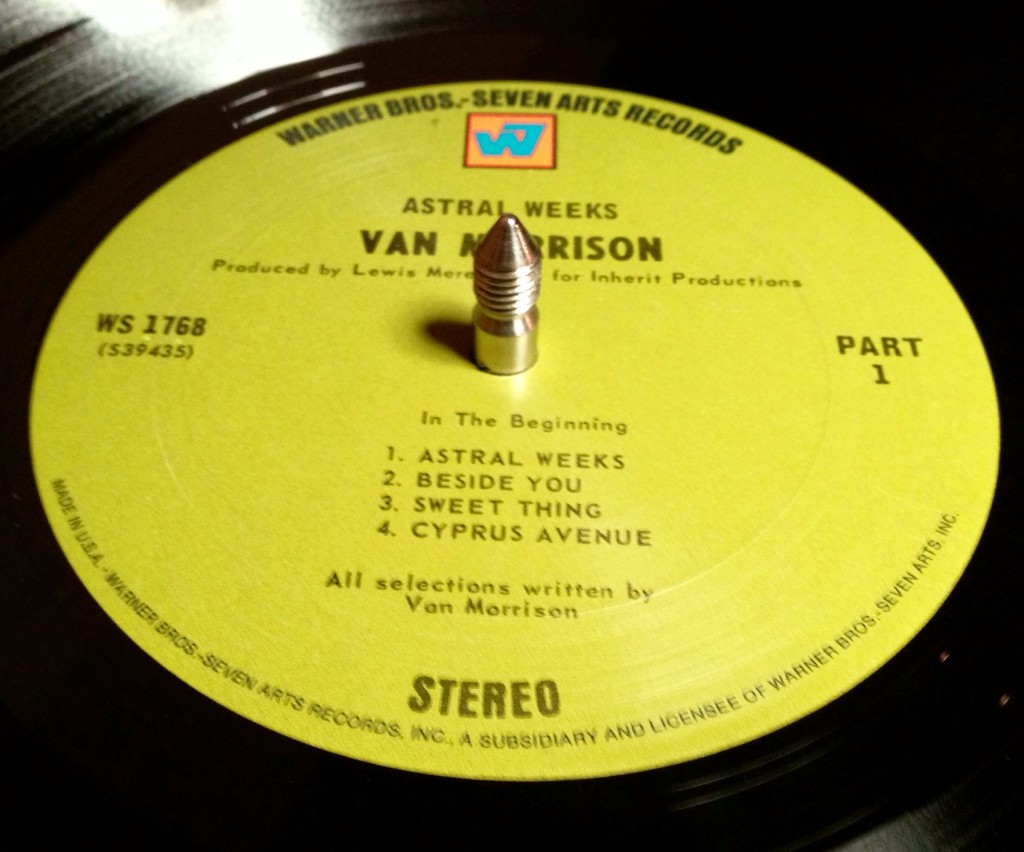
A closer look at that W7 label. The w7 logo may appear on the jacket, but not on the record label itself, so you have to look at both. And, since the logo may have been used by different pressing plants at different times, its appearance does not assure a pressing from a specific period unless you also know where it was pressed, something that may be revealed by the deadwax.
There are some well-known pressings of certain records that are considered “the ones,” but even that can be a bit subjective- where you are comparing different shadings of color or emphasis that one person may prefer depending on personal sonic preference, audio system characteristics and other factors. This becomes the fabric of the collector and in some cases is open to debate, at least as to sonics.
Keep in mind that most common, big-selling records from the 60’s and 70’s were commodities that were stamped out in the millions of copies (those were the days!) and less (than zero?) attention was paid by consumers to the particulars of deadwax, pressing plant, mastering engineer, and the like.
Decoding this information is a little like learning a lost language, and involves extracting details that were really never meant for public consumption- “insider codes” -hieroglyphics that have only become important as interest has increased in identifying the specifics, including sonics of older analog pressings.
Discogs provides matrix information, but it is a crowd-sourced site, so it is not entirely complete and there may be errors. In fact, collectors have discerned much of this information after-the-fact since factory information for a given record pressed at certain plants in a specific year or month is not something one can readily find, if it even exists. Some of it has been assembled on the web as a result of the efforts of collectors. (Pressing plants, along with mastering engineers, were not always owned or employed by the record labels themselves so just knowing that it is a Warner or Atlantic record from a certain era doesn’t tell you much). There are few Rosetta Stones, but much anecdotal information that has been assembled over the years. Here’s a cool thread on Hoffman that shows crowd-sourcing of this information in process-http://forums.stevehoffman.tv/threads/atlantic-atco-vinyl-labels-and-deadwax-what-do-the-codes-mean.285080/
And, another url about pressing plants: http://www.anorakscorner.com/PressingPlantInfo.html
A basic album search on Discogs is nonetheless a good starting point for a general search of any pop/rock album, to give you a sense of how many different pressings have been issued of a given record and some basic information about the deadwax. There are specialized sites for particular band discographies, like the one for Pink Floyd, http://pinkfloydarchives.com/discTOC.htm, or for the Vertigo label mentioned elsewhere on this site, http://vertigoswirl.com/, or for The Beatles,http://thebeatles-collection.com/wordpress/category/beatles-on-parlophone-records-original-albums/.
Pick any number of specific records by other bands and have a search. I can’t vouch for all of this information, but if there is a rare record you are after, it is listed on E-Bay for a reasonable starting price and you want to take a shot at it, you probably want to do this due diligence before you go into a bidding frenzy.
The problem isn’t that knowing this stuff will end your social life at cocktail parties; it is that it doesn’t tell you what a particular pressing sounds like compared to other pressings.[6] Collectors may want a first (or other specific) pressing with particular attributes for collectability purposes, something that is determined not just by this deadwax information, but other indicia including the label art on the record itself as well as the packaging. But since I’m in it for the music and sonics, I want to find the “best sounding copy” of a particular album, which may or may not be a first pressing, and then, a first pressing from which country? Which pressing plant? That means connecting the deadwax information, country of origin, date of pressing and other information with the sonic attributes of various pressings.[7] This takes us into the anecdotal and subjective world of the opinions of others.
So, here are a couple of starting points, which we will refine here and in later record reviews and articles on this site:
If there is a band or album you want, do a basic web search that says: “best vinyl pressing of [title of album][band].” You’ll wind up hitting many of the same sites for these debates. The Steve Hoffman forum is one of the places where you can find an almost endless number of threads discussing the merits of various pressings of certain records- but you then have to dig into those threads and start to learn who has really done the comparisons of the different pressings. Very few people have listened to every relevant pressing. Even the conventional wisdom as to the “best” for a particular record may still leave room for debate.
As but one example, for Led Zeppelin 1, I have many pressings and have heard many more. There is one that is simply outstanding, and it isn’t the most expensive, rare copy and is one that has frequently been mentioned on the Hoffman site. It is a later, mid-70’s remaster done by George Piros, with certain deadwax information below,[8] pressed at the Monarch plant on the West Coast. For a record that is not a very good recording in the first place, sonically, this is pretty much as good as it gets on vinyl. I reached this conclusion after listening and comparing a UK first press (with the same deadwax as the earliest rare Turquoise colored typeface jacket); a U.S. “east coast” first press; a U.S. “west coast” first press; a Classic Records 33 rpm reissue and a Classic Records 45 rpm reissue, among others. Are there other better sounding copies? Maybe. Some of the early Canadian pressings are supposed to be great, but I haven’t heard them.
For Led Zep II, I have several of the grail “RL” pressings and one in particular that is close to mint- killer sounding for a record that I have been listening to since its original release. The RL is generally regarded as the best sounding early pressing. [9] Yet, I also have an early UK “plum” of LZII which rocks just as hard, has more bass, and though it isn’t quite as “freight train” in its delivery it is just as punchy as the ‘RL’ in different ways. If compared, I’d say half the listeners in my room on my system will prefer the plum to the ‘RL.’[10] Me- I’ll listen to either depending on mood.
One last example, for now: Neil Young’s Harvest. I’ve really come to appreciate some of his records over the years. One of them is Harvest– it is just a great record and the early Lee Hulko pressings sound fantastic-there is that easy flow, an organic quality that sounds like real music, and less like a reproduction being played at you. The Classic Records Neil Young Greatest Hits has some tracks from Harvest that sound, to my ears, very detailed and “audiophile impressive” but a bit ‘zingy’ in places by comparison to the original record. (Chris Bellman did that remaster). Warner then reissued a series of Neil Young records, including Harvest, more recently. Chris Bellman, once again, did this remaster. It is not a rare or expensive record, and as far as I know, is still in print. Comparing all of these, the original Hulko is the most organic, the more recent Bellman Harvest is very close to the original, it presents more detail, but sounds, to my ears, a little more analytical (but not in a nasty way) than the Hulko (which some find a little congested sounding), yet the recent Bellman is not nearly as top end zingy as the Classic Records Greatest Hits Harvest cuts. (Same mastering engineer on both re-do’s). I still prefer the early Hulko but finding a clean, quiet copy isn’t easy- I think I have four Hulko copies, two are great, two are noisy. I could see someone saying why play the lottery? The Hulko isn’t particularly expensive but if I’m guaranteed a quiet player, I could see someone saying just buy the still in print Bellman re-do and be done. If only it were that easy for all records.
Why Shouldn’t I Just Buy the New Reissue?
I really don’t want to debate the merits of remasters and reissues v. earlier pressings- in many cases I own multiple copies of the same record, early or original pressing, japanese pressing, UK press, Canadian, sometimes a promo or even a test pressing, and a variety of remasters and reissues.
Every one sounds different.(Due to space limitations we will address country of origin separately).
Sometimes the re-do’s are great- the originals are hard to find in great condition, sometimes the remaster actually comes from an improved source (not often, but sometimes) and sometimes, some of the re-do’s, even when taken from a digital master- can improve on something that was just not a great recording to being with. (Here, I’m thinking of Tull’s Benefit album, which was remixed a couple years ago, taken from a digital master and it sounds, to my ears, better than the early UK and US pressings I also own; but, that was a pretty awful sounding recording to start with- muddy, muted, so the clarity of the re-do, partly owing to the remix and partly probably because of the digital source for it, improved a bad recording). And sometimes, the re-do’s or vinyl issues, though relatively new, are themselves rare:
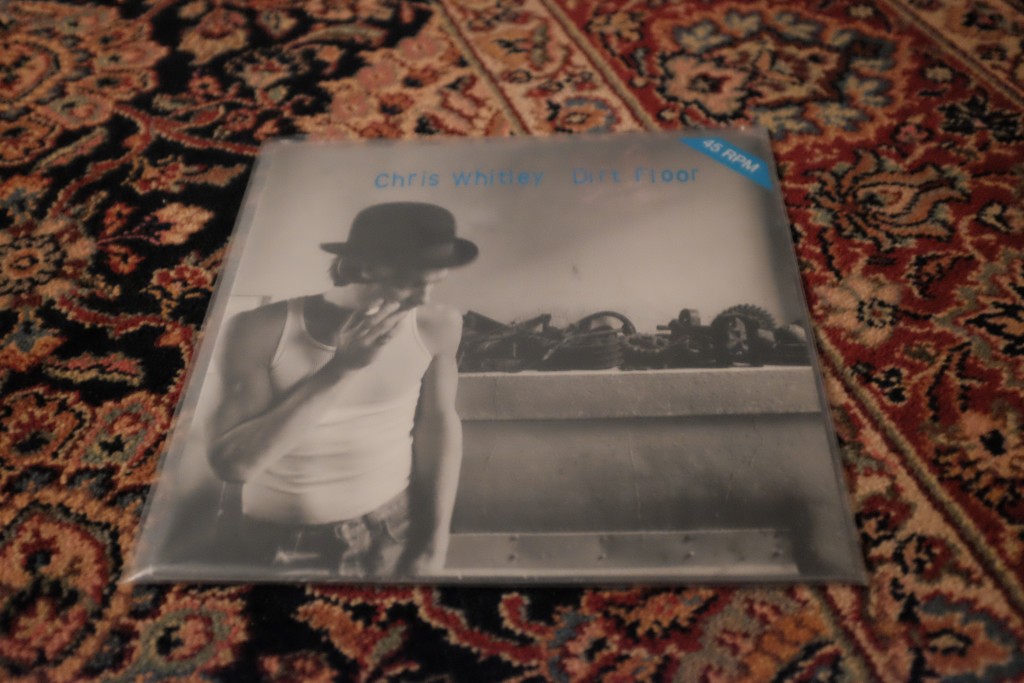
Chris Whitley’s “Dirt Floor” on Classic Records. I believe this was the first iteration released on vinyl, though Classic Records was better known for its remasters. The record is out of print and hard to find, although it isn’t that “old;” my suspicion is, it wasn’t a big seller for Classic Records. I got mine from Whitley’s label at the time, Messenger Records in NYC, which may still have a few copies for sale. (This one was purchased sealed, and it’s just superb; worth every penny just for the title track- minimalist recording by another extremely under-rated, almost forgotten talent that deserves renewed recognition).
The debate about digital versus analog is also one I’m going to avoid, other than to note that marketing hype like “180 gram Audiophile” reissue/remaster “taken from the original [analog] source” tells you nothing. Some reissue labels in the audiophile world are considered to be gold standards,[11] and these are well reviewed elsewhere,[12] but there are just as many, probably more, reissued records that come from questionable source material, probably digitized in some part of the process before being turned into a ‘new’ vinyl record and can sound flat and lifeless compared to a $2.00 bin copy of the old pressing found in a record store.
What you are getting (at best or worst, depending on your perspective) is clean, unmolested, and hopefully quiet vinyl. But the tales are legion of new vinyl issues that are warped, badly pressed, or just sound lousy, so buying the brand new “audiophile” reissue is no assurance that you are getting the best sound without doing a similar kind of research on the re-do: was it truly from the tape?[13] Who remastered it? What is the quality of the pressing? This is why I delved into this stuff in a more serious way – not because I wanted to buy or collect rare records, but because I wanted the best sound I could get for a particular piece of music from vinyl. Sometimes, that means you are buying an old yellow label Epic for 6 bucks American on E-Bay and you are done.
As mentioned, a lot of the re-do’s are already covered in the audio press – the best reviews are those which compare the new pressing to a variety of older, known quantities. (I buy some select remasters because some old records are extremely hard to find in great condition, except at connoisseur prices). Over the summer, I got to hear true first pressings, mono and stereo, of Junior Well’s Hoodoo Man Blues, with the “friendly chap” credit for Buddy Guy (Guy was signed to Chess Records and this was a Delmark album raising some contractual issues).
Killer. Sounding. Records. Four hundred dollar a pop mint condition original pressings in impeccable playing condition. Worth every penny in that condition, but I have and regularly enjoy a $50 dollar re-do from Chad a/k/a Analogue Productions, cut at 45 rpm that serves me just fine. (BTW, this is a “must have” record if only for the track “In the Wee Wee Hours.” This record sounds like you are in a jazz club; you can almost smell the cigarette smoke; it is an essential blues album in my estimation). Buddy Guy is still a smokin’ player too, so if he’s out there on a tour, catch him.[14]
Pricing- asking prices can be all over the place for the “same” record. I’m more interested in actual selling prices, which you can get from various websites, including http://www.popsike.com/. Even there, you will see that there is sometimes a wide margin in price. Bidding frenzy? Outlier? Date of the sale? Condition? Luck? (The markets for various records also go up and down over time).
Once you are on the hunt for particular records, you can get a general sense of the “right” price range- but here, I’m going to go back to the beginning- condition is everything. I’d rather pay $100 for a minty copy of an old desirable pressing than $40 for one that turns out to be shot, noisy and annoying to listen to because of groove damage (even if it is the “right” pressing). Many collectors buy a ‘starter’ copy and then upgrade. In my estimation, it’s cheaper in the long run to buy the keeper copy and sometimes, just sometimes, you score that under-market.
Vinyl records are a hot commodity these days- I’ve lived through bubbles in housing, exotic cars and other stuff. I don’t know if we are in a bubble right now on vinyl, so I can’t tell you that any of this is a great investment. Buy it because of the music and sound, not because your heirs are going to benefit.[15]
Wait a minute- after all this, you are telling me to do research but isn’t that why I reading this XD%$! site? Well, I will recommend or identify certain records and pressings on this site, but I can’t cover everything, I don’t know everything, your taste in music may differ from mine and you should get into the habit of doing the research yourself. There are some well-known “bests” (including the old “HP List” that the late, great Harry Pearson assembled in The Absolute Sound– true sonic showpieces in some cases). There are also “top records’ on various chat boards. But, I’m assuming you are not just looking for the tried and true ‘warhorses’ (many of which are classical, jazz and soundtracks that often show up on these lists or so-called “records to die from”- audiophile ‘demos’ that sound great but are vapid musically or you’ve heard so many times that they are no longer of interest); you may want to find the best sounding pressing of something that is not always on the standard lists of best sounding records. So, I’ll continue to review records, some off the beaten path, that are great musically and sonically. But I also want you to explore the methods and sources of information about how we find these jewels, aside from just presenting my conclusions. After all, learning is methodology, not just “information.” (And even with this lengthy piece, I’ve only covered the basics).
You may wind up owning many copies of some records, but in my experience, that’s more typical when the original recording just wasn’t that great to begin with. We can talk about all the copies of Tull’s Aqualung I own at some point and why the best sounding copy I’ve found is neither the most expensive nor rare.
Bill Hart
(With a thanks to “Max”)
[1] More about this below, but we are speaking of the ungrooved space between the end of last track grooves and the record label which is often inscribed with all sorts of information. These hieroglyphics can tell you much about the pressing, who mastered the record, where it was pressed (sometimes by actual pressing plant identification) and other obscure data that is informative for reasons described below. Occasionally, odd phrases, satanic incantations and other wacky stuff are inscribed there too. Sometimes “stamped” and sometimes hand inscribed, this is part detective job, part Egyptologist- the reading of mdju netjer (“words of the gods”). But, as explained below, it is still only part of the equation in evaluating a record.
[2] And this is where you can score sometimes on rare records if you are lucky.
[3] My friend Max pointed me to a listing for a collectible record that said that the dog bite marks that went through the jacket into the vinyl were only audible on one track. At least credit the seller for candor. Max is the same collector friend who received one old record mailed to him in a used pizza box that still had dried tomato sauce remnants.
[4] There are also telltales to this- sometimes, just looking at the ‘sealed wrapper’ suggests that it is not original. Sometimes, the ‘tight’ shrink had breathing holes which are not replicated in the “re-shrink’ process; some records were originally sealed in poly-type bags or heavier PVC outer jackets which do not present the same risk of warpage, but may raise other issues- having to do with the plasticizers in PVC leaching through to the record itself; this can cause visible and sometimes audible damage.
[5] This can also be the result of a bad cleaning but I know Max’s methods and we trade records, so this was not his doing. Frankly, I’d rather a seller not clean the record at all (unless they have already cleaned it to play grade it), and let me receive it in its original state, because I’m somewhat skeptical of the (undisclosed) cleaning methods used by some sellers. There are various things people can put on a record to make it” look good” that are contaminants.
[6] I’m going to throw one more variable in here which will drive you nuts, but it has to be mentioned; that is, copy to copy variability in sonics. Assume exactly the same deadwax info, pressing (particular issue, pressing plant, etc.) and condition; two otherwise “identical” records may sound different. Why? Because they aren’t really identical- when in the pressing process did the record get stamped? Were there variables, of temperature, of the vinyl compound, or other factors that make one “identical” copy sound better than another? Yes. I think that way lies madness, but it is a truth. There’s always a fair amount of controversy about “Better Records” who sell common pressings for a premium based on the notion that he and his staff have listened to many, many copies of the “same” record to pick out the “Hot Stamper.” I’m not going to wade into that quagmire other than to acknowledge that it exists and make no judgment about Better Records as a business. You can find any number of articles on web that seem to stir up some strong feelings, pro and con; me, I’d probably pay the tariff and buy 20 different copies of a ubiquitous old pressing and do it myself. (I have found that it is the badly recorded records that most often force me to buy multiple pressings to find a good sounding one, but these are almost always different pressings, and often from different countries).
[7] In some cases, the deadwax and metal parts information regarding the mother/stamper, etc. can carry over to later pressings, so you can find essentially the same deadwax info on different, later pressings. This is another short-cut to buying an expensive record on the cheap. See the example re Vertigo and WWA in the piece here on Black Sabbath.
[8] Piros is the mastering engineer who remastered the record in the mid-70’s and the pressing comes out of the Monarch plant. Thus:
Side1: ST-A-681461CC-REPL AT/GP MR(CIRCLED) (DELTA)18257(2) PR
Side2: ST-A-681462CC-REPL AT/GP MR(CIRCLED) (DELTA)18257-X(2) PR.
[9] I have yet to hear the Classic Records 45 rpm of LZII, a pressing that was only available, to my knowledge, in the “roadcase” offered by Classic; the case is about the size of the container of cash you’ll need to buy one of those sets today. My Classic 45 versions of 1 and 4 are very revealing, but at least for LZ 1, I prefer the Piros, which is far cheaper and easier to obtain.
[10] There are people who have posted various software analyses of these records- the ‘RL’ versus the ‘plum,’ and while it is interesting to look at the differences in the dynamic range and frequency spectra of the same tracks on both records, it still isn’t the same as listening to the records on your system and doing a sonic comparison yourself. Which is why many people wind up having multiple copies of the same record.
[11] Chad Kassem’s Analogue Productions, the “new’ Mobile Fidelity (there’s an old MoFi catalog which is a different critter), Classic Records (out of print and now owned by Chad under the umbrella of companies which he retails through his Acoustic Sounds website), Music Matters, Ltd. (which specializes in Blue Note jazz re-do’s) are among these. There are a lot of companies reissuing records these days, including the major labels themselves. Some of those,which aren’t terribly expensive, are pretty great, e.g.,Chris Bellman’s re-do of Neil Young’s Harvest mentioned above. But we are now delving into who did the (re)mastering, which is a whole other subject.
[12] Michael Fremer, who has done much to carry the torch during the nadir of the vinyl record, along with a few other sites, regularly review reissues/remasters and often compare them with older pressings.
[13] A lot of newly issued vinyl (as opposed to reissues of older records) starts with a digital master. I am not per se against that-but for records that started life in the older analog tape world, the preference remains for a full analog chain on the re-do, something that is not always clear from the release information.
[14] I’m going to throw out another Buddy Guy track here that has nothing to do with record buying as such. “The First Time I Met the Blues” shows up on a few different Buddy Guy albums and compilations but the absolute best rendition of it I have heard-not sonically, but for the Friendly Chap’s playing – is a performance from a soundtrack for an old documentary on the Chicago Blues scene, aptly entitled “Chicago Blues” filmed in the early 1970’s. Guy just rips this thing, the playing is stinging and bitter. It has issued in various forms, including on a DVD, a CD and (I think) on a vinyl pressing, including a compilation, but you want to find the version from the documentary, not another rendition- Guy recorded this song many times. It isn’t sonics we are after here- this is blues guitar that cuts you, and cuts you hard.
[15] One final point, literally- make sure there is some provision to deal with your record collection after your death. I cannot and will not offer you legal advice here, but remember, your executor is not going to have a clue as to value. That’s probably a whole other article that I might ask someone else to put together. I’m retired from lawyering, and I’d rather talk about things other than the law (though I still teach).
